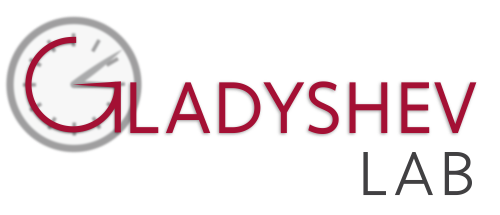Earlier Articles
Gladyshev VN, Kryukov GV, Fomenko DE, Hatfield DL. (2004) Identification of trace element-containing proteins in genomic databases. Annu. Rev. Nutr. 24, 579-596.
Wang C, Scott S, Tao Q, Fomenko DE, Gladyshev VN. (2004) New Techniques for Generation and Analysis of Evolutionary Trees. International Conference on Mathematics and Engineering Techniques in Medicine and Biological Sciences 283-289.
Su D, Gladyshev VN. (2004) Alternative splicing involving the thioredoxin reductase module in mammals: a glutaredoxin-containing thioredoxin reductase 1. Biochemistry 43, 12177-12188.
Carlson BA, Xu XM, Kryukov GV, Rao M, Berry MJ, Gladyshev VN, Hatfield,DL. (2004) Identification and characterization of phosphoseryl-tRNA[Ser]Sec kinase. Proc. Natl. Acad. Sci. USA 101, 12848-12853.
Kim HY, Gladyshev VN. (2004) Characterization of mouse endoplasmic reticulum methionine-R-sulfoxide reductase. Biochem. Biophys. Res. Commun. 320, 1277-1283.
Koc A, Gasch AP, Rutherford JC, Kim HY, Gladyshev VN. (2004) Methionine sulfoxide reductase regulation of yeast lifespan reveals reactive oxygen species-dependent and -independent components of aging. Proc. Natl. Acad. Sci. USA 101, 7999-8004.
Kryukov GV, Gladyshev VN. (2004) The prokaryotic selenoproteome. EMBO Rep. 5, 538-543.
Castellano S, Novoselov SV, Kryukov GV, Lescure A, Blanco E, Krol A, Gladyshev VN, Guigo R. (2004) Reconsidering the evolution of eukaryotic selenoproteins: a novel nonmammalian family with scattered phylogenetic distribution. EMBO Rep. 7, 71-77.
Kim HY, Gladyshev VN. (2004) Methionine sulfoxide reduction in mammals: characterization of methionine-R-sulfoxide reductases. Mol. Biol. Cell 15, 1055-1064.
Carlson BA, Novoselov SV, Kumaraswamy E, Lee BJ, Anver MR, Gladyshev VN, Hatfield DL. (2004) Specific excision of the selenocysteine tRNA[Ser]Sec (Trsp) gene in mouse liver demonstrates an essential role of selenoproteins in liver function. J. Biol. Chem. 279, 8011-8017.
Fomenko DE, Gladyshev VN. (2003) Genomics perspective on disulfide bond formation. Antioxid. Redox Signal. 5, 397-402.
Kwon SY, Badenhorst P, Martin-Romero FJ, Carlson BA, Paterson BM, Gladyshev VN, Lee BJ, Hatfield DL. (2003) The Drosophila selenoprotein BthD is required for survival and has a role in salivary gland development. Mol. Cell. Biol. 23, 8495-8504.
Fomenko DE, Gladyshev VN. (2003) Identity and functions of CxxC-derived motifs. Biochemistry 42, 11214-11225.
Thisse C, Degrave A, Kryukov GV, Gladyshev VN, Obrecht-Pflumio S, Krol A, Thisse B, Lescure A. (2003) Spatial and temporal expression patterns of selenoprotein genes during embryogenesis in zebrafish. Gene Expr. Patterns 3, 525-532.
Rao M, Carlson BA, Novoselov SV, Weeks DP, Gladyshev VN, Hatfield DL. (2003) Chlamydomonas reinhardtii selenocysteine tRNA[Ser]Sec. RNA 9, 923-930.
Kryukov GV, Castellano S, Novoselov SV, Lobanov AV, Zehtab O, Guigo R, Gladyshev VN. (2003) Characterization of mammalian selenoproteomes. Science 300, 1439-1443.
Kumaraswamy E, Carlson BA, Morgan F, Miyoshi K, Robinson GW, Su D, Wan, S, Southo, E, Tessaroll, L, Le, B J, Gladyshe, VN, Hennighausen L, Hatfield DL. (2003) Selective removal of the selenocysteine tRNA [Ser]Sec gene (Trsp) in mouse mammary epithelium. Mol. Cell. Biol. 23, 1477-1488.
Novoselov SV, Gladyshev VN. (2003) Non-animal origin of animal thioredoxin reductases: Implications for selenocysteine evolution and evolution of protein function through carboxy-terminal extensions. Protein Sci. 12, 372-378.
Xu XM, Carlson BA, Grimm TA, Kutza J, Berry MJ, Arreola R, Fields, KH, Shanmugam I, Jeang KT, Oroszlan S, Combs GF, Marx PA, Gladyshev VN, Clouse KA, Hatfield DL. (2002) Rhesus monkey simian immunodeficiency virus infection as a model for assessing the role of selenium in AIDS. J. Acquir. Immune. Defic. Syndr. 31, 453-463.
Fomenko DE, Gladyshev VN. (2002) CxxS: fold-independent redox motif revealed by genome-wide searches for thiol/disulfide oxidoreductase function. Protein Sci. 11, 2285-2296.
Kumar RA, Koc A, Cerny RL, Gladyshev VN. (2002) Reaction mechanism, evolutionary analysis, and role of zinc in Drosophila methionine-R-sulfoxide reductase. J. Biol. Chem. 277, 37527-37535.
Novoselov SV, Rao M, Onoshko NV, Zhi H, Kryukov GV, Xiang Y, Weeks DP, Hatfield DL, Gladyshev VN. (2002) Selenoproteins and selenocysteine insertion system in the model plant cell system. Chlamydomonas reinhardtii. EMBO J. 21, 3681-3693.
Kryukov GV, Kumar RA, Koc A, Sun Z, Gladyshev VN. (2002) Selenoprotein R is a zinc-containing stereo-specific methionine sulfoxide reductase. Proc. Natl. Acad. Sci. USA 99, 4245-4250.
Korotkov KV, Novoselov SV, Hatfield DL, Gladyshev VN. (2002) Mammalian selenoprotein in which selenocysteine (Sec) incorporation is supported by a new form of Sec insertion sequence element. Mol. Cell. Biol. 22, 1402-1411.
Gladyshev VN. (2002) Thioredoxin and peptide methionine sulfoxide reductase: convergence of similar structure and function in distinct structural folds. Proteins 146, 149-152.
Hatfield DL, Gladyshev VN. (2002) How selenium has altered our understanding of the genetic code. Mol. Cell. Biol. 22, 3565-3576.
Sun Q, Gladyshev VN. (2002) Redox regulation of cell signaling by thioredoxin reductase. Methods Enzymol. 347, 451-461.
Gladyshev VN, Liu A, Novoselov SV, Krysan K, Sun QA, Kryukov VM, Kryukov GV, Lou MF (2001) Identification and characterization of a new mammalian glutaredoxin (thioltransferase) Grx2. J. Biol. Chem. 276, 30374-30380.
Martin-Romero FJ, Kryukov GK, Lobanov AV, Carlson BA, Lee BJ, Gladyshev VN, Hatfield DL. (2001) Selenium metabolism in Drosophila: selenoproteins, selenoprotein mRNA expression, fertility and mortality. J. Biol. Chem. 276, 29798-29804.
Moustafa ME, Carlson BA, El-Saadani MA, Kryukov GV, Sun Q.-A, Harney JW, Hill KE, Combs GF, Feigenbaum L, Mansur DB, Burk RF, Berry MJ, Diamond AM, Lee BJ, Gladyshev VN, Hatfield DL. (2001) Selective inhibition of selenocysteine tRNA maturation and selenoprotein synthesis in transgenic mice expressing isopentenyladenosine mutant selenocysteine tRNA transgenes. Mol. Cell. Biol. 21, 3840-3852.
Sun Q-A, Kirnarsky L, Sherman S, Gladyshev VN. (2001) Selenoprotein oxidoreductase with specificity for thioredoxin and glutathione systems. Proc. Natl. Acad. Sci. USA 98, 3673-3678.
Korotkov KV, Kumaraswamy E, Zhou Y, Hatfield DL, Gladyshev VN. (2001) Association between the 15 kDa selenoprotein and UDP-glucose:glycoprotein glucosyltransferase in the endoplasmic reticulum of mammalian cells. J. Biol. Chem. 276, 15330-15336.
Hu YJ, Korotkov KV, Mehta R, Hatfield DL, Rotimi C, Luke A, Prewitt TE, Cooper RS, Stock W, Vokes EE, Dolan ME, Gladyshev VN, Diamond AM. (2001) Distribution and functional consequences of nucleotide polymorphisms in the 3′-untranslated region of the human Sep15 gene. Cancer Res. 61, 2307-2310.
Sun Q-A, Zappacosta F, Factor VM, Wirth P, Hatfield DL, Gladyshev VN. (2001) Heterogeneity within animal thioredoxin reductases: evidence for alternative first exon splicing. J. Biol. Chem. 276, 3106-3114.
Gladyshev VN, Kryukov GV. (2001) Evolution of selenocysteine-containing proteins: significance of identification and functional characterization of selenoproteins. BioFactors 14, 87-92.
Gladyshev VN, Diamond DL, Hatfield DL. (2001) The 15 kDa selenoprotein (Sep15): functional studies and a role in cancer etiology. In Selenium: its molecular biology and role in human health (ed., Hatfield DL), Kluwer Academic Publishers, pp. 147-155.
Gladyshev VN. (2001) Selenium in biology and human health: controversies and perspectives. In Selenium: its molecular biology and role in human health (ed., Hatfield DL), Kluwer Academic Publishers, pp. 313-317.
Gladyshev VN, Hatfield DL. (2001) Analysis of selenocysteine-containing proteins. Curr. Protoc. Protein Sci. 3, 3.8.
Kumaraswamy E, Malykh A, Korotkov KV, Kozyavkin S, Hu Y, Moustafa ME, Carlson B, Berry MJ, Lee BJ, Hatfield DL, Diamond AM, Gladyshev VN. (2000) Structure-expression relationships of the 15 kDa selenoprotein gene: possible role of the protein in cancer etiology. J. Biol. Chem. 275, 35540-35547.
Kryukov GV, Gladyshev VN. (2000) Selenium metabolism in zebrafish: multiplicity of selenoprotein genes and expression of a protein containing seventeen selenocysteine residues. Genes Cells 5, 1049-1060.
Mansur DB, Hao H, Gladyshev VN, Korotkov K, Hu Y, Moustafa ME, El-Saadani MA. Carlson BA, Hatfield DL, Diamond AM. (2000) Multiple levels of regulation of selenoprotein biosynthesis revealed from the analysis of human glioma cell lines. Biochem. Pharm. 60, 489-497.
Gladyshev VN, Stadtman TC, Hatfield DL, Jeang KT. (1999) Levels of major selenoproteins in T cells decrease during HIV infection and low molecular mass selenium compounds increase. Proc. Natl. Acad. Sci. USA 96, 835-839.
Gladyshev VN, Jeang KT, Wootton JC, Hatfield DL. (1998) A new human selenium-containing protein: purification, characterization and cDNA sequence. J. Biol. Chem. 273, 8910-8915.
Boyington JC, Gladyshev VN, Khangulov SV, Stadtman TC, Sun PD. (1997) Crystal structure of formate dehydrogenase H: catalysis involving molybdenum, molybdopterin, selenocysteine and an Fe4S4 cluster. Science 275, 1305-1308.
Gladyshev VN, Jeang KT, Stadtman TC. (1996) Selenocysteine, identified as the penultimate C- terminal residue in human T-cell thioredoxin reductase, corresponds to TGA in the human placental gene. Proc. Natl. Acad. Sci. USA 93, 6146-6151.
Gladyshev VN, Boyington JC, Khangulov SV, Grahame DA, Stadtman TC, Sun PD. (1996) Characterization of crystalline formate dehydrogenase H from Escherichia Coli: stabilization, EPR spectroscopy and preliminary crystallographic analysis. J. Biol. Chem. 271, 8095-8100.



